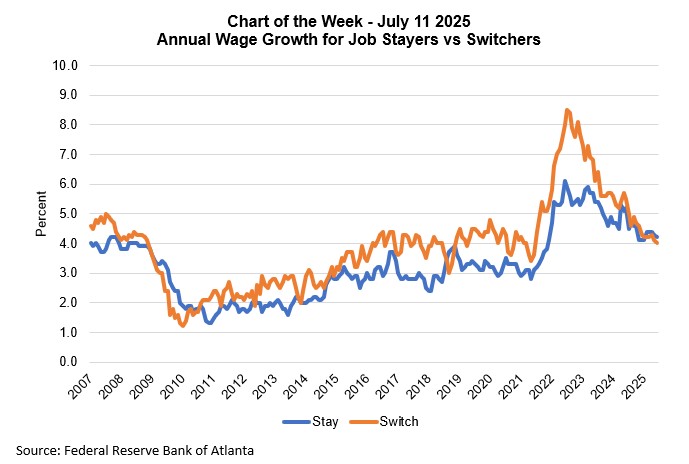
Chart of the Week: Average Wage Growth for Job Stayers Vs. Switchers

Given the current economic uncertainty, a lot of attention is being paid to the health of the labor market. Overall, it is fair to say that the job market is still healthy but continues to weaken. Based on the Bureau of Labor Statistics’ Employment Situation report, job growth came in at 147,000 in June, matching the average pace for the past year. The unemployment rate remained steady at 4.1%, but the participation rate dropped again, as workers continued to leave the workforce.
Job gains were concentrated in just a few sectors, with half of the June’s job gains in state and local government, leaving private sector job gains at 74,000, at half their pace of recent months. Effectively all the new private sector jobs were in education, health care, and hospitality. The diffusion index, a measure of the breadth of job gains across the economy, dipped below 50 for the second time in three months, indicating that less than half of the industry sectors were adding new jobs.
Wage growth declined to 3.7% over the past year, consistent with a slower pace of hiring. At some point, we expect wage growth to decelerate further if the unemployment rate begins to rise, moving bargaining power from employees to employers. Evidence of this shift can already be seen in the Federal Bank of Atlanta’s wage tracker series on wage growth for workers switching jobs compared to those staying in current jobs. As shown in this week’s chart, workers switching to new jobs (represented by the orange line) have historically seen more wage gains than those who are staying in their current jobs (represented by the blue line). However, the two series have converged recently and for the past three months, the wage premium from switching has disappeared and those staying are seeing stronger wage growth. The last time we saw this happen for an extended period was during the 2009-2010 recession.
For now, most of these data are in line with market expectations and are likely to keep the Federal Reserve on hold at its next meeting. If the job market does weaken further, as it is showing signs of doing, there will likely be two cuts to the federal funds target later this year and an additional cut in 2026.
–Mike Fratantoni (mfratantoni@mba.org); Joel Kan (jkan@mba.org)
